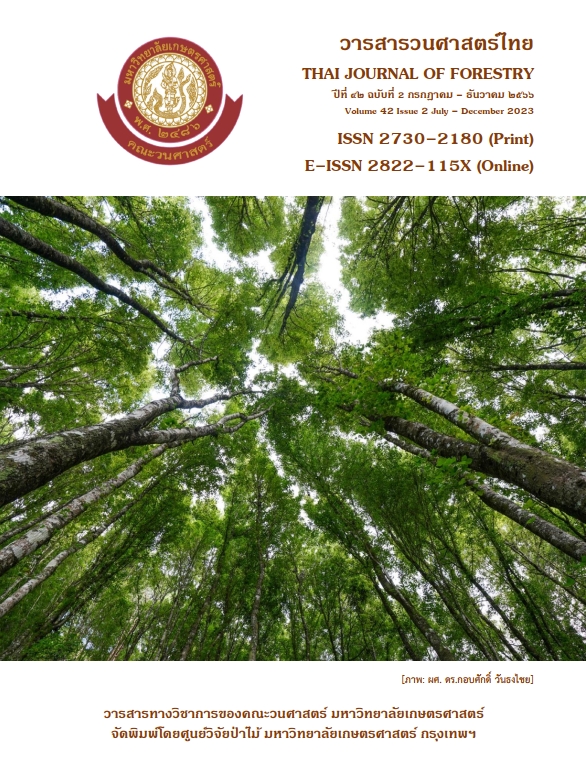The Termite (Subterranean Macrotermes carbonarius) attack Rating of Thermally Treated Teak (Tectona grandis L.f.) Plywood Thermal treatment of wood modification
Main Article Content
บทคัดย่อ
Thermal treatment on teak veneer has been recognized as the improved biological property protection method of teak-plywood product from the termite attacking. The objective was investigated how much rating of teak plywood that attacked by termite at the different level of temperature and length of time. The temperatures were at the control, 180, 200, 220, and 240 °C applied at three different lengths of time, i.e., 4, 8, and 12 min on teak veneer sheets. The plywood production was applied two type adhesives with Phenol formaldehyde PF and Urea Formaldehyde UF, both samples was placed in the ground (50 cm deep, 50 cm width and 5 m length with contact with termite home). As the results showed the evidence attacked by termite at different level of temperature at 220 and 240 °C on 4, 8, and 12 min was significant different it is increased as per the temperature in both adhesives. Thermal treatment veneer at 220 and 240 °C can protected termite attacking on teak plywood product as well.
Downloads
Article Details

อนุญาตภายใต้เงื่อนไข Creative Commons Attribution-NonCommercial-NoDerivatives 4.0 International License.
ข้าพเจ้าและผู้เขียนร่วม (ถ้ามี) ขอรับรองว่า ต้นฉบับที่เสนอมานี้ยังไม่เคยได้รับการตีพิมพ์และไม่ได้อยู่ในระหว่างกระบวนการพิจารณาตีพิมพ์ลงในวารสารหรือสิ่งตีพิมพ์อื่นใด ข้าพเจ้าและผู้เขียนร่วม (ถ้ามี) ยอมรับหลักเกณฑ์และเงื่อนไขการพิจารณาต้นฉบับ ทั้งยินยอมให้กองบรรณาธิการมีสิทธิ์พิจารณาและตรวจแก้ต้นฉบับได้ตามที่เห็นสมควร พร้อมนี้ขอมอบลิขสิทธิ์ผลงานที่ได้รับการตีพิมพ์ให้แก่วารสารวนศาสตร์ คณะวนศาสตร์ มหาวิทยาลัยเกษตรศาสตร์ กรณีมีการฟ้องร้องเรื่องการละเมิดลิขสิทธิ์เกี่ยวกับภาพ กราฟ ข้อความส่วนใดส่วนหนึ่ง หรือ ข้อคิดเห็นที่ปรากฏในผลงาน ให้เป็นความรับผิดชอบของข้าพเจ้าและผู้เขียนร่วม (ถ้ามี) แต่เพียงฝ่ายเดียว และหากข้าพเจ้าและผู้เขียนร่วม (ถ้ามี) ประสงค์ถอนบทความในระหว่างกระบวนการพิจารณาของทางวารสาร ข้าพเจ้าและผู้เขียนร่วม (ถ้ามี) ยินดีรับผิดชอบค่าใช้จ่ายทั้งหมดที่เกิดขึ้นในกระบวนการพิจารณาบทความนั้น”
เอกสารอ้างอิง
Arinana, A., Aldina, R., Nandika, D., Rauf, A., Harahap, I.S., Sumertajaya, I.M., Bahtiar, E.T. 2016. Termite Diversity in Urban Landscape, South Jakarta, Indonesia. Insects, 7:20. https://doi.org/10.3390/insects7020020
Australian/New Zealand Standard. 2012. Plywood-Structural. Part 0: Specifications. Australia: Council of Standard Australia, Australia.
Bekhta, P., Sedliacik, J., Saldan, R., Novak, I. 2016. Effect of different hardeners for urea-formaldehyde resin on properties of birch plywood. Acta Facultatis Xylologiae Zvolen, 58: 65-72. doi:10.17423/afx.2016.58.2.07
Dunky, M. 1998. Urea–formaldehyde (UF) adhesive resins for wood. International Journal of Adhesion and Adhesives, 18(2), 95-107. doi:10.1016/s0143-7496(97)00054-7
Dunky, M. 2003. Adhesives in the Wood Industry. In: Handbook of Adhesive Technology. CRC Press, Boca Raton, Florida, USA.
Isanapong, J. 2016. Roles of Verrucomicrobia in lower termite hindgut. The Journal of Applied Science, 15(2): 103-119. doi:doi:10.14416/j.appsci.2016.12.001 (in Thai)
Kausar, A. 2017. Role of thermosetting polymer in structural composite. American Journal of Polymer Science & Engineering, 5(1): 1-12.
Grace, J.K., Yamamoto, R.T. 1994. Natural resistance of Alaska-cedar, redwood, and teak to Formosan subterranean termites. Forest Products Journal, 44(3): 41-45.
Li, H., Lu, J., Mo, J. 2012. Physiochemical lignocellulose modification in the formosan subterranean termite Coptotermes Formosanus Shiraki (Isoptera: Rhinotermitidae) and potential uses in the production of biofuels. Bioresources, 7(1): 675-685.
Lukmandaru, G. 2015. Chemical Characteristics of Teak Wood Attacked by Neotermes tectonae. BioResources, 10(2): 2094-2102. doi:10.15376/biores.10.2.2094-2102
Lwin, M., Yezin, Tawm N.P. 2003. Study on utilization of plantation teak pre-project CFC/ITTO 73 FT PPD 68/03 Rev.2 (I). In: Hand Book on Properties of Plantation Teak in Myanmar. Ministry of Forestry, Forest Department Myanmar: CFC/ITTO 73 FT PPD 68/03 Rev.2 (I), Myanmar.
Miyagawa, S., Koyama, Y., Kokubo, M., Matsushita, Y., Adachi, Y., Sivilay, S., Kawakubo, N., Oba, S. 2011. Indigenous utilization of termite mounds and their sustainability in a rice growing village of the central plain of Laos. Journal of Ethnobiology and Ethnomedicine, 7(1): 24. doi: 10.1186/1746-4269-7-24
Moubarik, A., Pizzi, A., Allal, A., Charrier, F., Charrier, B. 2009. Cornstarch and tannin in phenol–formaldehyde resins for plywood production. Industrial Crops and Products, 30(2): 188-193. doi:10.1016/j.indcrop.2009.03.005
Nakabonge, G., Matovu, B. 2021. Variation in susceptibility of Eucalyptus grandis and selected hybrid clones to two termite species Macrotermes bellicosus and M. subhyalinus in Uganda. All Life, 14(1): 120-126. doi: 10.1080/26895293.2021.1883126
Norton. 2019. Durability Workshop. Retrieved from State of Queensland: https://creativecommons.org/licenses/by/4.0/, 18 August 2023.
Nuryawan, A., Risnasari, I., Sucipto, T., Heri Iswanto, A., Rosmala Dewi, R. 2017. Urea-formaldehyde resins: production, application, and testing. IOP Conference Series: Materials Science and Engineering, 223(1): 012053. doi: 10.1088/1757-899X/223/1/012053
Pacific Agribusiness Research and Development Initiative. 2007. Teak Value Chain Review. University of Adiliade: Australaine Center for International Agriculture Research, Australia.
Thipsantia, P. 2011. Biodiversity of Termites and their Relationship to Dry Dipterocarp and Dry Evergreen Ecosystems at Sakaerat Environmental Research Station, Nakhon Ratchasima Province. M.S. Thesis, Institute of Science. Suranaree University of Technology, Nakhon Ratchasima, Thailand. (in Thai)
Roszaini, K., Salmiah, U., Dahlan, J.M. 2006. Natural Resistance of Timbers to Termite Attack: Laboratory Evaluation of the Resistance of Malaysian Wood Against Coptotermes Curvignathus (Holmgren). Journal of the Institute of Wood Science, 17(3): 178-182. doi: 10.1179/wsc.2006.17.3.178
Rust, M.K., Su, N.Y. 2012. Managing social insects of urban importance. Annual Review of Entomology, 57(1): 355-75. doi:10.1146/annurev-ento-120710-100634
Sornnuwat, Y., Vongkaluang, C., Chutibhapakorn, S. 2003. Foraging patterns of termite species in the living complex of Bangkanoon forest plantation, Phuket province, southern Thailand. The International Research Group on Wood Preservation. Document IRG/WP, 03-10481. Brisbane, Australia.
Su, N.Y., Scheffrahn, R.H. 2000. Termites as Pests of Buildings. In: Abe, T., Bignell, D.E., Higashi, M. (eds). Termites: Evolution, Sociality, Symbioses, Ecology. Springer Netherlands. Dordrecht, pp. 437-453. doi: 10.1007/978-94-017-3223-920
Thai Commercial Corperation LTD. No dated. Technical Document of Plywood Class E-2. In. Thailand. (in Thai)
TOA-Dovechem Industries Co.Ltd. No dated. Phenol Formaldehyde. Samut Prakarn, Thailand.
Wang, X., Li, J., Zhang, J., Gao, Q. 2012. Technics and Properties of Plywood Manufacture with Modified Urea-Formaldehyde Resin. Advanced Materials Research, 602-604: 743-746. doi:10.4028/www.scientific.net/AMR.602-604.743
Vongkaluang, C., Charoenkrung, K. 2008. Termites: prevention and removation. In: Termites. Bangkok: Aksorn Siam. Bangkok, Thaialnd. (in Thai)


